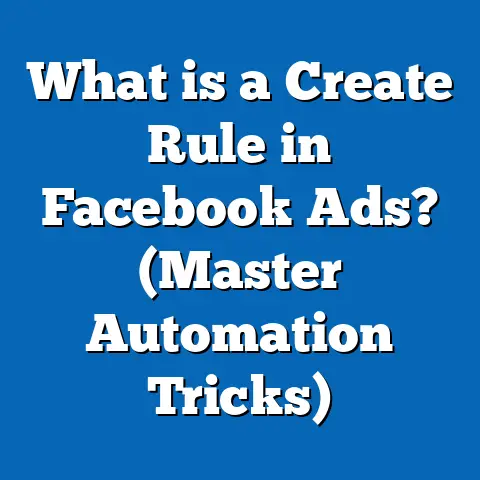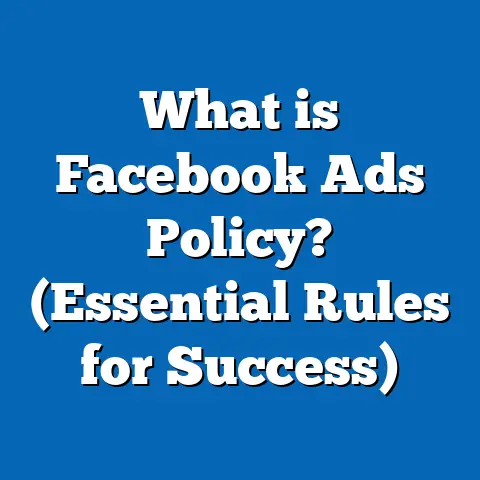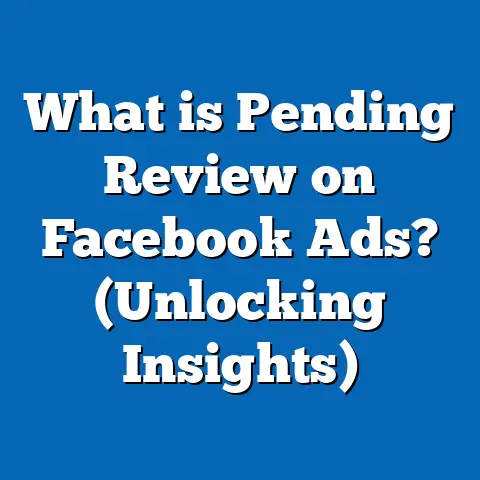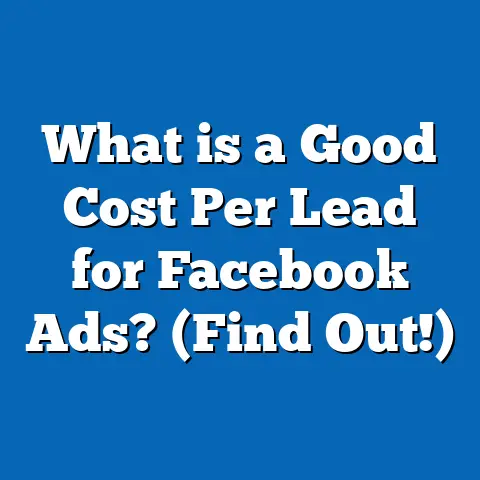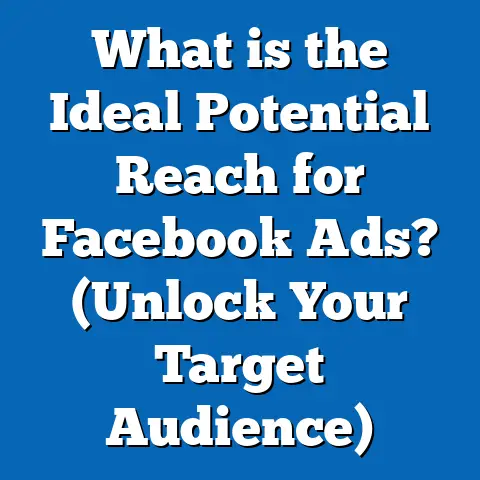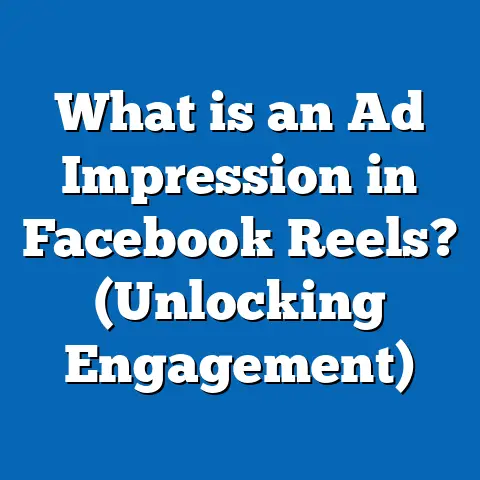What is Overlay Ads on Facebook? (Unlock Engagement Secrets)
Introduction: My First Encounter with Overlay Ads on Facebook
A few years back, I was managing a small e-commerce brand struggling to gain traction in a crowded digital market. Our budget was tight, and traditional Facebook ads in the news feed were not delivering the engagement or conversions we needed. One afternoon, while scrolling through the Facebook app, I noticed an advertisement appearing over a video I was watching—not as a separate post but directly on top of the content in a way that didn’t feel intrusive but immediately caught my eye. These were overlay ads.
Curious, I explored this new ad format and decided to test it with a small budget. To my surprise, the results were immediate and impactful: a 25% increase in click-through rates and higher onsite engagement. This experience changed how I approached Facebook advertising forever. Today, overlay ads have become a powerful tool for marketers worldwide looking to maximize attention and conversions on one of the most competitive social platforms.
This guide will take you through everything you need to know about Facebook overlay ads—from basic definitions and benefits to advanced tactics, real-world case studies, and future trends. Whether you’re a marketing professional or a business owner, this resource will unlock the secrets to using overlay ads effectively.
What Are Overlay Ads on Facebook?
Definition and Context
Overlay ads on Facebook refer to advertisements that appear layered over existing content rather than replacing or appearing beside it. Unlike traditional ads that occupy fixed spaces in the news feed or sidebar, overlay ads “float” over videos, stories, or other interactive elements. This makes them more dynamic and capable of capturing user attention without fully interrupting their experience.
How They Differ From Other Ad Formats
Traditional Facebook ads come in several formats: static images in the feed, carousel ads with multiple images or videos, video ads, stories ads, and more. Overlay ads are unique because:
- They appear over other content, such as videos or stories.
- They are usually short-lived, designed to capture attention quickly.
- They often include interactive elements like buttons or forms within the overlay.
- Their placement is contextual—meaning they show up precisely when users are engaged with specific content.
This format’s subtlety combined with visibility makes overlay ads a hybrid between native advertising and direct-response marketing.
Types of Facebook Overlay Ads
Facebook offers several types of overlay advertising options:
- Video Overlay Ads: Appear during video playback on Facebook or Instagram. These ads typically show as a semi-transparent banner or box positioned at the bottom or center of the video frame.
- Instant Experience Overlays: Full-screen mobile ads that open instantly when clicked but can also include overlays within the experience itself to highlight products or calls to action.
- Stories Overlay Ads: Displayed over Facebook or Instagram Stories, these ads blend into the ephemeral nature of Stories but remain interactive through tap actions.
- Messenger Overlay Ads: These appear inside the Messenger app during conversations or while interacting with chatbots.
Why Overlay Ads Matter in Facebook Marketing
The Challenge of Attention on Facebook
Facebook’s platform is saturated with content competing for user attention—posts from friends, videos, news articles, memes, and advertisements all fight for eyes and clicks. According to Statista, as of 2024, over 2.9 billion people use Facebook monthly. With so many users and so much content, capturing attention is harder than ever.
The Power of Overlay Ads
Overlay ads stand out because they appear directly over engaging content users are already focused on—videos or stories—without forcing them to scroll past unrelated ads. This positioning dramatically increases the likelihood of users noticing and interacting with the ad.
Data-Backed Insights
- Engagement Increase: A 2023 Social Media Examiner study found overlay ads increase engagement rates by approximately 30% compared to traditional feed placements.
- Higher CTR: Facebook’s own data highlights that video overlays can increase click-through rates by 15-25%, especially when including clear call-to-actions (CTAs).
- Reduced Bounce Rates: Overlay ads linked with Instant Experiences help reduce bounce rates by up to 20% as users engage without leaving the platform.
- Ad Recall: Nielsen research shows that overlay ads improve brand recall by 35% versus standard banner ads.
Why Marketers Prefer Overlay Ads
Marketers appreciate overlay ads because they:
- Deliver better ROI through higher engagement.
- Can be precisely targeted using Facebook’s powerful audience tools.
- Offer flexibility in formats—from video banners to interactive story elements.
- Help combat ad fatigue by integrating seamlessly with content.
How Do Overlay Ads Work on Facebook?
To understand how overlay ads function, it’s essential to break down the process into key stages:
1. Audience Targeting
Facebook’s detailed targeting system lets advertisers define their ideal audience through:
- Demographic filters (age, gender, location)
- Interests and lifestyle behaviors
- Custom audiences (existing customers or website visitors)
- Lookalike audiences (users similar to your best customers)
Overlay ads rely on this targeting to ensure the right message reaches the right people at the right time.
2. Placement Optimization
Facebook’s ad delivery system automatically selects where overlays will appear based on:
- Content type (video length, story format)
- User device (mobile vs desktop)
- Historical performance data
- Bid amount and competition
Advertisers can specify placements but often rely on Facebook’s AI for optimization.
3. Creative Development
Because overlays float atop content, creatives must be:
- Visually striking but not disruptive
- Clearly branded
- Including concise text and strong CTAs
- Optimized for different screen sizes and devices
4. Real-Time Bidding
Facebook uses a real-time auction system where advertisers bid for impressions based on target audience value and campaign goals.
5. Measurement & Analytics
Every interaction is tracked via:
- Facebook Pixel integration on advertiser websites
- In-app metrics for views, clicks, engagements
- Conversion tracking tools measuring downstream sales or leads
This data helps optimize future campaigns for better performance.
Advantages of Using Overlay Ads on Facebook
Overlay ads bring several strategic advantages:
1. Superior Engagement
Because overlays appear directly over engaging content like videos or stories, they command greater user focus and prompt interactions more effectively than standard ads.
2. Increased Conversion Rates
Overlay ads typically result in higher conversion rates due to their contextual relevance and interactive elements like “Shop Now” buttons or embedded forms.
3. Cost Efficiency
By targeting users who are already engaged with content and optimizing placements automatically, advertisers often see better cost-per-click (CPC) and cost-per-action (CPA) metrics.
4. Reduced Ad Blindness
Many users develop “banner blindness” toward static or sidebar ads. Overlays integrate with content flow, bypassing this psychological filter.
5. Mobile Optimization
Overlay ads are especially suited for mobile users where screen space is limited but engagement potential is high; they fit naturally into Stories or video experiences.
Deep Dive: Technical Aspects Explained Simply
How Does Facebook Ensure Overlays Are Not Too Intrusive?
Facebook uses design rules and frequency caps:
- Overlays must be semi-transparent or small enough to avoid blocking core video content.
- Frequency capping limits how often one user sees an overlay ad within a given time frame.
- Users can often close overlays if they find them distracting.
What Is Facebook Pixel & Why Is It Important?
The Facebook Pixel is a snippet of code installed on your website that tracks user actions after clicking an ad (e.g., purchases, signups). For overlay ads:
- Pixel data helps measure ROI accurately.
- It enables retargeting campaigns for users who interacted but didn’t convert.
- Pixel insights inform creative optimization by revealing which overlays drive conversions.
How Does Real-Time Bidding Affect Overlay Ads?
Real-time bidding means your ad competes with others every time it tries to show up. If:
- Your bid is too low or your ad relevance score is poor, your overlay might not appear.
- If high relevance + good bid = higher chances of overlay being shown to prime audience segments.
Practical Examples and Case Studies
Case Study 1: Fashion Retailer Sees 40% Sales Lift with Video Overlays
Background: A mid-sized online fashion retailer wanted to boost sales during a seasonal campaign.
Strategy: They used video overlay ads during product demo videos showing models wearing new arrivals. The overlays included “Shop Now” CTAs directly linked to product pages.
Results: Within three months:
- Sales attributed to Facebook increased by 40%.
- Click-through rates improved by 22%.
- Return on ad spend (ROAS) increased by 3X compared to previous campaigns.
Case Study 2: SaaS Company Boosts Lead Generation by 35% with Instant Experience Overlays
Background: A SaaS provider aimed to increase free trial signups using lead capture forms embedded in Instant Experience overlays.
Strategy: Created interactive overlays where users could fill signup forms without leaving Facebook.
Results:
- Lead generation increased by 35%.
- Cost per lead dropped by 18%.
- User time spent interacting with the ad increased by an average 45 seconds, indicating high engagement.
Case Study 3: Non-Profit Gains Awareness via Story Overlays
A non-profit working on environmental awareness launched an Instagram Stories overlay campaign combining short video messages with donation CTAs directly embedded in overlays.
Outcome:
- Donations increased by 25% during campaign period.
- Story views rose by 50%, enhancing brand visibility.
Comparison: Overlay Ads vs Other Advertising Platforms
| Feature | Facebook Overlay Ads | Google Display Network | YouTube Mid-Roll Ads | Instagram Stories Ads |
|---|---|---|---|---|
| Placement | Overlaid on videos/stories | Banner/side placements | Video interruptions | Full-screen ephemeral |
| User Experience | Integrated with content | Separate from content | Interruptive | Immersive & ephemeral |
| Engagement Rate | High (15-25% CTR uplift) | Moderate | Medium | High |
| Targeting Granularity | Very granular via FB data | Moderate | High (based on Google data) | Very granular (FB-owned) |
| Cost Efficiency | Generally cost-effective | Variable | Higher due to mid-roll nature | Competitive |
How to Create Effective Facebook Overlay Ads: Step-by-Step Guide
Step 1: Set Clear Objectives
Define whether your goal is:
- Brand awareness
- Lead generation
- Direct sales/conversions
- Event registrations
Overlay ad creatives should align tightly with these objectives for maximum impact.
Step 2: Choose Appropriate Overlay Format
Decide between:
- Video overlay banners
- Instant Experience overlays with interactive elements
- Story overlays optimized for vertical mobile screens
Consider where your audience spends most time.
Step 3: Craft Compelling Creatives
Best practices include:
- Using bold colors that contrast yet complement underlying content.
- Clear branding visible within seconds.
- Short copy focused on benefits or offers.
- Strong call-to-action buttons like “Learn More,” “Sign Up,” “Buy Now.”
Step 4: Apply Advanced Targeting
Use combination targeting:
- Core demographics + interest layers
- Custom audiences from your email lists or website visitors
- Lookalikes based on high-value customers
This ensures overlays reach engaged prospects ready to act.
Step 5: Launch Campaign & Monitor Closely
Track KPIs such as:
- CTR (Click-through rate)
- CPC (Cost per click)
- CPA (Cost per acquisition)
- Engagement rate (likes, comments, shares) Adjust bids and creatives based on performance data bi-weekly or monthly.
Advanced Strategies for Maximizing Overlay Ad Performance
A/B Testing Creatives & Placements
Test variations like:
- Different CTA texts (“Shop Now” vs “Get Offer”)
- Placement positions (bottom vs center)
- Video length (15 seconds vs 30 seconds) Analyze which has better engagement or conversion metrics.
Leveraging Retargeting Funnels
Use overlay ads as part of multi-stage funnels:
- Awareness via broad targeting overlays
- Retarget warm audiences with personalized offers
- Convert cold leads using strong CTAs in overlays
Integrating User Generated Content (UGC)
Overlay ads featuring authentic customer testimonials or reviews often boost credibility and trust—leading to higher conversions.
Combining Overlays With Offline Campaigns
Use QR codes embedded in overlays directing users to offline stores or events—bridging digital and physical touchpoints seamlessly.
Common Challenges & Solutions
| Challenge | Solution |
|---|---|
| Ad Fatigue | Rotate creatives regularly; update offers |
| User Annoyance | Keep overlays subtle; allow easy dismissal |
| Difficulty Measuring ROI | Use Facebook Pixel; set clear conversion goals |
| Creative Restrictions | Follow Facebook guidelines; test different formats |
| Budget Constraints | Start small; optimize before scaling |
Industry Trends Shaping Overlay Ads in 2024 and Beyond
AI-Powered Dynamic Creative Optimization
AI tools now automatically customize overlay ad elements based on real-time user reactions—optimizing headlines, images, and CTAs dynamically.
Augmented Reality Integration
Brands use AR overlays in Stories—allowing users to “try on” products or visualize services interactively within an ad itself.
Shopping Directly Through Overlays
With Facebook Shops integration, overlays enable seamless product browsing and purchasing inside the platform without redirects.
Cross-Platform Campaign Synchronization
Running simultaneous overlay campaigns across Facebook, Instagram, Messenger enhances reach while maintaining consistent messaging.
Glossary of Key Terms Related to Facebook Overlay Ads
| Term | Definition |
|---|---|
| Call-to-action (CTA) | A prompt encouraging user action (e.g., Buy Now) |
| Real-time bidding | Auction process where advertisers bid for ad placement |
| Facebook Pixel | Tracking code that measures user interactions post-ad click |
| Lookalike Audience | Audience similar in behavior to existing customers |
| Instant Experience | Full-screen mobile ad format offering immersive user journey |
| Ad Fatigue | Decline in user response due to repetitive exposure |
Summary: Unlocking Engagement Secrets with Facebook Overlay Ads
Overlay ads offer marketers a unique way to capture attention within an already engaging context—videos or stories—leading to higher engagement rates, better conversions, and cost-efficient campaigns. By understanding their mechanics, leveraging data-backed strategies, and continuously optimizing creative and targeting approaches, businesses can achieve remarkable results even within crowded digital landscapes.
Remember:
- Always align your ad format with campaign goals.
- Use compelling visuals paired with clear CTAs.
- Test constantly and analyze performance thoroughly.
- Stay updated with platform changes and emerging technologies like AI & AR.
Implementing these best practices unlocks powerful engagement secrets available through Facebook overlay advertising today.
If you want me to provide additional sections such as templates for overlay ad creatives, a detailed setup tutorial inside Facebook Ads Manager including screenshots, or a checklist for campaign optimization, please let me know!

